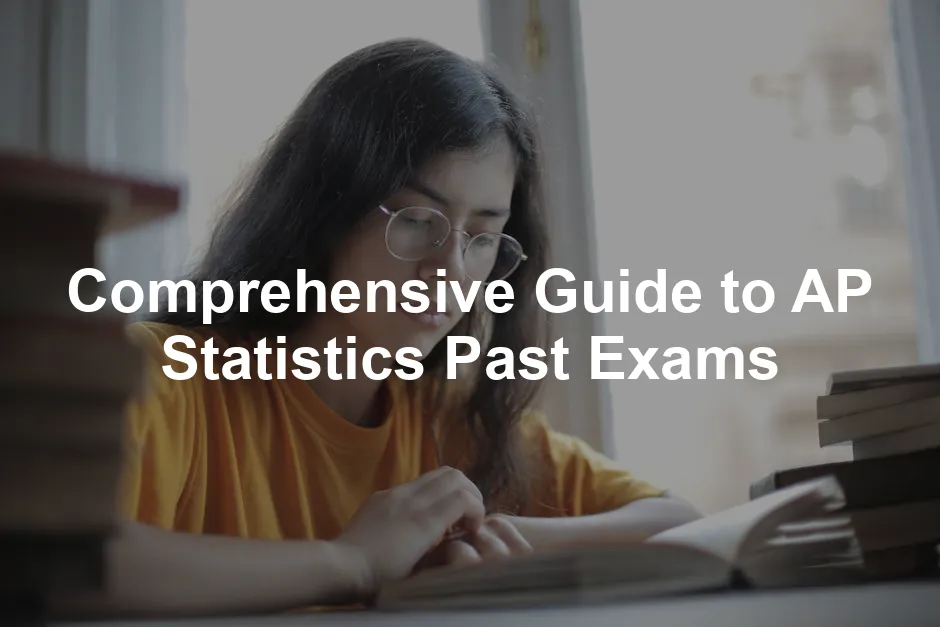Introduction
The AP Statistics exam is more than just another test. It’s your golden ticket to college readiness! High school students who ace this exam not only earn college credit but also gain essential analytical skills. These skills are crucial in today’s data-driven world. But let’s be real; preparing for this exam can feel like trying to find Waldo in a sea of red and white stripes.
Reviewing past exams stands out as a fantastic study tool. Why, you ask? Because practice makes perfect, and nothing screams “I’m ready!” like tackling real exam questions. Past exams help you familiarize yourself with the types of questions you’ll face. They also illuminate areas needing a little extra attention, like a spotlight on your math skills.
In this blog post, we will dive into a treasure trove of resources. We’ll discuss strategies that help you conquer the exam. We’ll also provide insights on past exams and how to make them your best friends during study sessions. So, grab your graphing calculator and let’s get started!

Understanding the AP Statistics Exam Format
Overview of the Exam Structure
The AP Statistics exam is structured into two main sections: Multiple Choice and Free Response.
Section I: Multiple Choice
– Number of Questions: 40
– Duration: 1 hour and 30 minutes
– Weight: 50% of the total score
This section consists of individual questions and sets that revolve around common prompts. It’s like a buffet of statistical concepts, where you get to feast on a variety of topics!
Section II: Free Response
– Number of Questions: 6
– Duration: 1 hour and 30 minutes
– Weight: 50% of the total score
The free-response section is a bit different. Here, you’ll find multipart questions that require more in-depth answers. You’ll be asked about data collection, exploration, and inference tasks. Think of it as the exam’s way of saying, “Show me what you can do!”
Understanding the balance of these sections is crucial. The exam’s structure is designed to assess your overall grasp of statistics, so don’t neglect either side.
Key Concepts Assessed
The AP Statistics exam covers a smorgasbord of topics, including:
- Sampling distributions
- Inference
- Data analysis
These key concepts are the backbone of the exam. For a more detailed understanding, check out the AP Statistics Exam Format. It provides a comprehensive outline of what to expect.
Arming yourself with this knowledge can make a world of difference in your preparation. So, keep this guide handy as you navigate the wild world of AP Statistics!

Importance of Practicing with Past Exams
Benefits of Using Past Exam Papers
Practicing with past exam papers is like having a secret weapon in your academic arsenal. It helps you identify knowledge gaps faster than a magician pulling rabbits out of a hat. When you tackle these questions, you quickly discover the concepts you understand and the ones that need a little more TLC.
Familiarity is key, especially when it comes to exam formats. Past exams expose you to the types of questions you’ll encounter, easing the stress of test day. It’s like a dress rehearsal before the big show—without the costume malfunctions!
Let’s not forget about the pressure cooker of time constraints. Practicing under timed conditions simulates real exam scenarios. This experience helps you manage your time effectively while fostering mental resilience. Who needs stress balls when you can channel that energy into practice?
Lastly, the psychological benefits of practicing with past papers are immense. You gain confidence as you recognize patterns in questions. With every practice session, you build a mental library of strategies that can turn anxiety into excitement. It’s all about transforming the “what ifs” into “I got this!”

Practicing with past exam papers is crucial for mastering the AP Statistics exam. Explore tips for effective data analysis that can enhance your practice sessions.
Accessing AP Statistics Past Exam Resources
Official College Board Resources
When it comes to finding reliable AP Statistics past exam resources, look no further than the College Board. They are the masterminds behind the exam, and their official site is a treasure trove of information. You can access a plethora of past exam questions, scoring guidelines, and sample responses that provide invaluable insights into what graders are looking for.
For instance, you can download free-response questions from various years, complete with scoring distributions. This is like having a cheat sheet that reveals the secrets of successful answers. For a comprehensive list of past free-response questions, check out the College Board’s official page here.
Let’s not skip the scoring information either! Grasping how your answers are evaluated can make all the difference. Understanding the scoring guidelines can help you tailor your responses to meet the expectations of the examiners.

Third-party Resources
In addition to official resources, numerous third-party platforms offer a wealth of past papers and practice questions. Websites like MyMathsCloud and Save My Exams cater to students with a variety of formats, including PDFs and online quizzes. You’ll find everything from complete past exam papers to targeted practice questions for specific topics.
For example, MyMathsCloud boasts an impressive collection of 87 past papers from 1997 to 2023. You can easily download them in PDF format, making it convenient to print and practice. This resource is particularly handy for those who prefer studying offline.
Save My Exams also features a range of past papers, crafted by experienced educators who know the ins and outs of the AP Statistics exam. Their resources often include detailed explanations and solutions, ensuring you understand the reasoning behind each answer.
So, whether you prefer the classic PDF format or interactive online quizzes, there’s no shortage of options to help you prepare. Dive into these resources, and you’ll be well-equipped to tackle the complexities of AP Statistics!
Organizing Resources by Year
When it comes to AP Statistics past exams, organization is key. We’ve compiled a comprehensive list of past exams from 1997 to 2023. You can easily access free-response questions and scoring guidelines for quick reference.
Here’s a handy format for each entry: Year – Question Type – Scoring Guidelines. This way, you won’t have to sift through endless data to find what you need.

1997
– Free-Response Questions: Access Here
– Scoring Guidelines: View Scoring
1998
– Free-Response Questions: Access Here
– Scoring Guidelines: View Scoring
1999
– Free-Response Questions: Access Here
– Scoring Guidelines: View Scoring
2000
– Free-Response Questions: Access Here
– Scoring Guidelines: View Scoring
2001
– Free-Response Questions: Access Here
– Scoring Guidelines: View Scoring
2002
– Free-Response Questions: Access Here
– Scoring Guidelines: View Scoring
2003
– Free-Response Questions: Access Here
– Scoring Guidelines: View Scoring
2004
– Free-Response Questions: Access Here
– Scoring Guidelines: View Scoring
2005
– Free-Response Questions: Access Here
– Scoring Guidelines: View Scoring
2006
– Free-Response Questions: Access Here
– Scoring Guidelines: View Scoring
2007
– Free-Response Questions: Access Here
– Scoring Guidelines: View Scoring
2008
– Free-Response Questions: Access Here
– Scoring Guidelines: View Scoring
2009
– Free-Response Questions: Access Here
– Scoring Guidelines: View Scoring
2010
– Free-Response Questions: Access Here
– Scoring Guidelines: View Scoring
2011
– Free-Response Questions: Access Here
– Scoring Guidelines: View Scoring
2012
– Free-Response Questions: Access Here
– Scoring Guidelines: View Scoring
2013
– Free-Response Questions: Access Here
– Scoring Guidelines: View Scoring
2014
– Free-Response Questions: Access Here
– Scoring Guidelines: View Scoring
2015
– Free-Response Questions: Access Here
– Scoring Guidelines: View Scoring
2016
– Free-Response Questions: Access Here
– Scoring Guidelines: View Scoring
2017
– Free-Response Questions: Access Here
– Scoring Guidelines: View Scoring
2018
– Free-Response Questions: Access Here
– Scoring Guidelines: View Scoring
2019
– Free-Response Questions: Access Here
– Scoring Guidelines: View Scoring
2020
– Free-Response Questions: Access Here
– Scoring Guidelines: View Scoring
2021
– Free-Response Questions: Access Here
– Scoring Guidelines: View Scoring
2022
– Free-Response Questions: Access Here
– Scoring Guidelines: View Scoring
2023
– Free-Response Questions: Access Here
– Scoring Guidelines: View Scoring
With this organized collection, you can focus on the materials that matter most. Prepare like a pro, and soon enough, you’ll be confidently tackling those exam questions!

Insights from Chief Reader Reports
The Chief Reader Reports provide a goldmine of insights for AP Statistics students. They highlight common pitfalls and areas where students often trip up. For example, many students misinterpret questions. They might overlook key details or fail to apply the correct statistical methods. This often leads to answers that don’t reflect their true understanding.
Another frequent issue? Misuse of terminology! Students sometimes confuse basic concepts like “mean” and “median.” This confusion can lead to incorrect conclusions and lower scores. So, it’s crucial to master the language of statistics.
Understanding scoring distributions is equally important. These distributions show how students performed across various questions and sections. By reviewing this data, students can gauge their performance relative to peers. It helps identify strengths and weaknesses, allowing for focused study.
Remember, the goal is to learn from these insights. Avoid the mistakes others made and improve your exam strategy. Knowledge is power, especially when it comes to AP Statistics!

Strategies for Effective Exam Preparation
Study Techniques
Now that we’ve explored insights from Chief Reader Reports, let’s talk about effective study techniques. First up: spaced repetition. This method involves reviewing material over increasing intervals. It’s science-backed! Studies show that spreading out study sessions boosts long-term memory retention. So, instead of cramming the night before, give yourself time to breathe.
Next, consider active recall. This technique means testing yourself on the material. Flashcards are fantastic for this! Write down questions on one side and answers on the other. Quiz yourself regularly. It’s like having a mini-exam every day!
Don’t underestimate the power of study groups. Collaborating with peers can enhance understanding. You can discuss tricky concepts and quiz each other. Plus, it’s much more fun than studying alone. Online forums can also be beneficial. Platforms like Reddit or specific Facebook groups allow you to connect with fellow students. Sharing resources and strategies can ease the study burden.
Finally, mix it up! Use various resources—videos, practice questions, and textbooks. This variety keeps things fresh and engaging. You’ll find out which methods resonate best with your learning style.

Creating a Study Schedule
Now that you have effective study techniques, let’s whip up a sample study schedule. The key is to balance your study time across different topics. Start with a two-month countdown before the exam.
Week 1-2: Focus on foundational concepts. Spend 2-3 days on each topic. Incorporate practice questions after each study session.
Week 3-4: Transition to more complex topics. Devote a week to sampling distributions and another to inference. Include group study sessions to clarify doubts.
Week 5: Take a full practice exam under timed conditions. This simulates the real deal! Analyze your results. Identify weak spots for further review.
Week 6-7: Focus on free-response questions. Spend a few days reviewing past FRQs. Write out full answers and seek feedback from teachers or peers.
Week 8: Review everything! Revisit your notes, practice exams, and key concepts. Schedule another full practice exam.
Final Week: Lighten up on heavy studying. Focus instead on refreshing your memory. Engage in review games or watch videos.
Balancing your study time is crucial. By mixing it up, you’ll keep your brain engaged and ready to tackle the exam!

Mock Exam Conditions
Simulating exam conditions is a brilliant strategy! Think of it as preparing for a marathon, but instead of running, you’re tackling statistics. By mimicking the actual exam environment during practice sessions, you build endurance. This practice reduces anxiety when the big day arrives.
Set a timer for the exact duration of the exam. No peeking at your notes; that’s cheating! Create a quiet space, just like the test room. Eliminate distractions—yes, that includes your phone!
Start with a warm-up by reviewing key concepts. Then, dive into practice questions. Treat this session as the real deal. Focus on managing your time, as it’s a crucial skill. You might feel your heart racing, but that’s normal. Embrace the pressure; it’s part of the game.
When you finish, take a deep breath! Review your answers just like a pro. Analyze your mistakes. Did you misinterpret a question? Or were the calculations off? This feedback loop is vital for improvement.
By the time exam day rolls around, you’ll feel like a seasoned veteran. You’ll know what to expect, and that’s half the battle won. So, gear up, simulate those conditions, and watch your confidence soar!

FAQs
Where can I find past AP Statistics exams?
You can find past AP Statistics exams on the official College Board website. They offer a variety of free-response questions and scoring guidelines. For even more resources, check out educational platforms like MyMathsCloud and Save My Exams.
How should I use past exams for studying?
Start by reviewing the exam format and types of questions. Take notes on your strengths and weaknesses as you practice. Focus on areas where you struggle, and make sure to revisit those topics.
What should I focus on while practicing free-response questions?
Pay attention to organization and clarity. Ensure your answers are precise and mathematically accurate. Practice writing out your solutions in a clear, logical manner. This will help you earn those precious points!
Are there any official practice tests available?
Yes! The College Board provides official practice tests, including complete released exams from previous years. These are excellent resources to familiarize yourself with the exam structure.
How can I track my progress while studying?
Keep a study journal. After each practice exam, note your scores and the questions you missed. This record helps you identify patterns and adjust your study strategies accordingly. You can also use apps or spreadsheets to monitor your progress over time.
To keep your study sessions comfortable and productive, consider investing in a good ergonomic study chair. Your back will thank you for it after those long study marathons!
Please let us know what you think about our content by leaving a comment down below!
Thank you for reading till here 🙂
All images from Pexels




